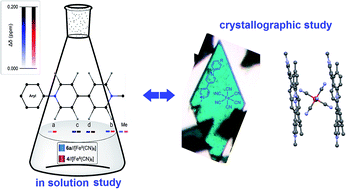Supramolecular complexes involving non-symmetric viologen cations and hexacyanoferrate(ii) anions. A spectroscopic, crystallographic and computational study†
Abstract
We have investigated spectrally, crystallographically as well as computationally the charge transfer complexes involving newly synthesized N-aryl-N′-methyl non-symmetric viologens (AMVs) and hexacyanoferrate(II) (HCF) anions. The supramolecular binding of AMVs and HCF was studied in solution and in the crystal state for one of the obtained complexes. Substituent effects on the electron affinities of the dicationic AMVs, determined using Mulliken's theory [R. S. Mulliken, J. Am. Chem. Soc., 1952, 74, 811–824] were quantified. The structure of one of the AMV//FeII(CN)6 pairs solved through Single-Crystal X-ray Diffraction (SCXRD), provided insights for the supramolecular binding of the anionic and cationic counterparts and the role of lattice water molecules. Supramolecular binding in solution, studied with the use of NMR spectroscopy, is in agreement with the results obtained in the solid state.


 Please wait while we load your content...
Please wait while we load your content...